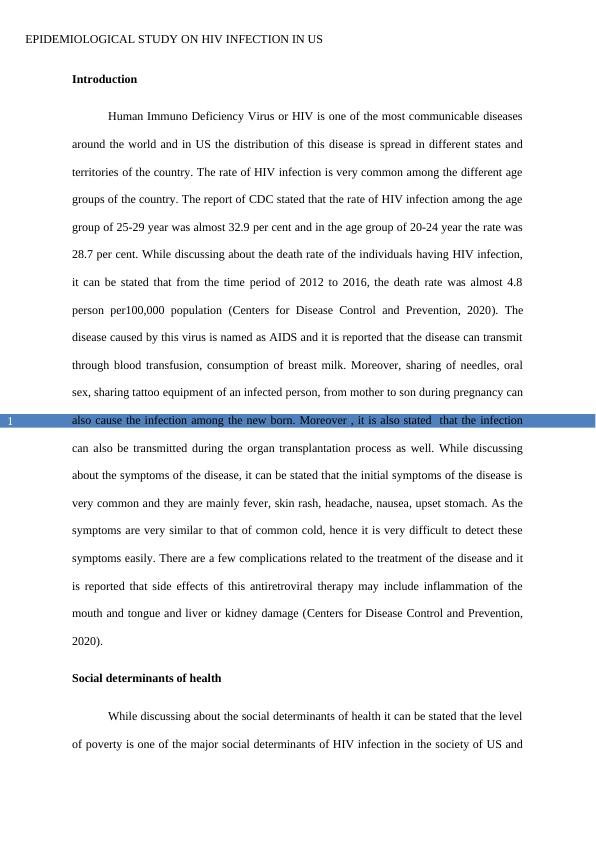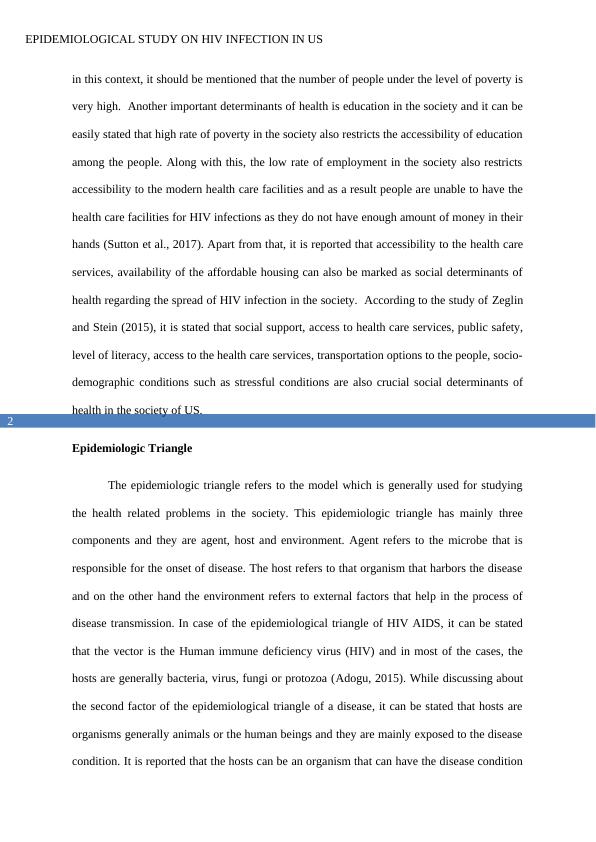Epidemiological Study On Hiv Infection
Added on 2022-08-13
12 Pages2992 Words15 Views
Running head: EPIDEMIOLOGICAL STUDY ON HIV INFECTION IN US
Epidemiological Study on HIV infection in US
Name of the Student
Name of the University
Author Note
Epidemiological Study on HIV infection in US
Name of the Student
Name of the University
Author Note

EPIDEMIOLOGICAL STUDY ON HIV INFECTION IN US
1
Introduction
Human Immuno Deficiency Virus or HIV is one of the most communicable diseases
around the world and in US the distribution of this disease is spread in different states and
territories of the country. The rate of HIV infection is very common among the different age
groups of the country. The report of CDC stated that the rate of HIV infection among the age
group of 25-29 year was almost 32.9 per cent and in the age group of 20-24 year the rate was
28.7 per cent. While discussing about the death rate of the individuals having HIV infection,
it can be stated that from the time period of 2012 to 2016, the death rate was almost 4.8
person per100,000 population (Centers for Disease Control and Prevention, 2020). The
disease caused by this virus is named as AIDS and it is reported that the disease can transmit
through blood transfusion, consumption of breast milk. Moreover, sharing of needles, oral
sex, sharing tattoo equipment of an infected person, from mother to son during pregnancy can
also cause the infection among the new born. Moreover , it is also stated that the infection
can also be transmitted during the organ transplantation process as well. While discussing
about the symptoms of the disease, it can be stated that the initial symptoms of the disease is
very common and they are mainly fever, skin rash, headache, nausea, upset stomach. As the
symptoms are very similar to that of common cold, hence it is very difficult to detect these
symptoms easily. There are a few complications related to the treatment of the disease and it
is reported that side effects of this antiretroviral therapy may include inflammation of the
mouth and tongue and liver or kidney damage (Centers for Disease Control and Prevention,
2020).
Social determinants of health
While discussing about the social determinants of health it can be stated that the level
of poverty is one of the major social determinants of HIV infection in the society of US and
1
Introduction
Human Immuno Deficiency Virus or HIV is one of the most communicable diseases
around the world and in US the distribution of this disease is spread in different states and
territories of the country. The rate of HIV infection is very common among the different age
groups of the country. The report of CDC stated that the rate of HIV infection among the age
group of 25-29 year was almost 32.9 per cent and in the age group of 20-24 year the rate was
28.7 per cent. While discussing about the death rate of the individuals having HIV infection,
it can be stated that from the time period of 2012 to 2016, the death rate was almost 4.8
person per100,000 population (Centers for Disease Control and Prevention, 2020). The
disease caused by this virus is named as AIDS and it is reported that the disease can transmit
through blood transfusion, consumption of breast milk. Moreover, sharing of needles, oral
sex, sharing tattoo equipment of an infected person, from mother to son during pregnancy can
also cause the infection among the new born. Moreover , it is also stated that the infection
can also be transmitted during the organ transplantation process as well. While discussing
about the symptoms of the disease, it can be stated that the initial symptoms of the disease is
very common and they are mainly fever, skin rash, headache, nausea, upset stomach. As the
symptoms are very similar to that of common cold, hence it is very difficult to detect these
symptoms easily. There are a few complications related to the treatment of the disease and it
is reported that side effects of this antiretroviral therapy may include inflammation of the
mouth and tongue and liver or kidney damage (Centers for Disease Control and Prevention,
2020).
Social determinants of health
While discussing about the social determinants of health it can be stated that the level
of poverty is one of the major social determinants of HIV infection in the society of US and

EPIDEMIOLOGICAL STUDY ON HIV INFECTION IN US
2
in this context, it should be mentioned that the number of people under the level of poverty is
very high. Another important determinants of health is education in the society and it can be
easily stated that high rate of poverty in the society also restricts the accessibility of education
among the people. Along with this, the low rate of employment in the society also restricts
accessibility to the modern health care facilities and as a result people are unable to have the
health care facilities for HIV infections as they do not have enough amount of money in their
hands (Sutton et al., 2017). Apart from that, it is reported that accessibility to the health care
services, availability of the affordable housing can also be marked as social determinants of
health regarding the spread of HIV infection in the society. According to the study of Zeglin
and Stein (2015), it is stated that social support, access to health care services, public safety,
level of literacy, access to the health care services, transportation options to the people, socio-
demographic conditions such as stressful conditions are also crucial social determinants of
health in the society of US.
Epidemiologic Triangle
The epidemiologic triangle refers to the model which is generally used for studying
the health related problems in the society. This epidemiologic triangle has mainly three
components and they are agent, host and environment. Agent refers to the microbe that is
responsible for the onset of disease. The host refers to that organism that harbors the disease
and on the other hand the environment refers to external factors that help in the process of
disease transmission. In case of the epidemiological triangle of HIV AIDS, it can be stated
that the vector is the Human immune deficiency virus (HIV) and in most of the cases, the
hosts are generally bacteria, virus, fungi or protozoa (Adogu, 2015). While discussing about
the second factor of the epidemiological triangle of a disease, it can be stated that hosts are
organisms generally animals or the human beings and they are mainly exposed to the disease
condition. It is reported that the hosts can be an organism that can have the disease condition
2
in this context, it should be mentioned that the number of people under the level of poverty is
very high. Another important determinants of health is education in the society and it can be
easily stated that high rate of poverty in the society also restricts the accessibility of education
among the people. Along with this, the low rate of employment in the society also restricts
accessibility to the modern health care facilities and as a result people are unable to have the
health care facilities for HIV infections as they do not have enough amount of money in their
hands (Sutton et al., 2017). Apart from that, it is reported that accessibility to the health care
services, availability of the affordable housing can also be marked as social determinants of
health regarding the spread of HIV infection in the society. According to the study of Zeglin
and Stein (2015), it is stated that social support, access to health care services, public safety,
level of literacy, access to the health care services, transportation options to the people, socio-
demographic conditions such as stressful conditions are also crucial social determinants of
health in the society of US.
Epidemiologic Triangle
The epidemiologic triangle refers to the model which is generally used for studying
the health related problems in the society. This epidemiologic triangle has mainly three
components and they are agent, host and environment. Agent refers to the microbe that is
responsible for the onset of disease. The host refers to that organism that harbors the disease
and on the other hand the environment refers to external factors that help in the process of
disease transmission. In case of the epidemiological triangle of HIV AIDS, it can be stated
that the vector is the Human immune deficiency virus (HIV) and in most of the cases, the
hosts are generally bacteria, virus, fungi or protozoa (Adogu, 2015). While discussing about
the second factor of the epidemiological triangle of a disease, it can be stated that hosts are
organisms generally animals or the human beings and they are mainly exposed to the disease
condition. It is reported that the hosts can be an organism that can have the disease condition

EPIDEMIOLOGICAL STUDY ON HIV INFECTION IN US
3
or can be a animal carrier which acts as carrier of the disease. In case of the HIV infection,
the host is human being as in human body the virus can live easily and can multiply
themselves and as a result people are having the disease named AIDS (Adogu, 2015). The
third component of the epidemiological triangle is the environmental or the external factors
that helps in the growth of the virus or the causative factor of the disease. In case of HIV
infection no such external factor are not present as, they mainly grow inside the human body.
However, there are a few external conditions that may enhance the rate of HIV infections in
the people. For example, it can be stated that the unsafe sexual practices, lack of knowledge
regarding the disease condition, poor accessibility to the health care services can also enhance
the chances of having infections among the people (Adogu, 2015).
Role of the Community Health Nurse
While discussing about the role of nurses present in the health care settings, it can be
stated that the role of nurses is very crucial as they play key role in reducing the rate of
infection among the people. As per the data of the World Health Organization, it is stated that
the role of the community nurses are very crucial for reducing the impact of this devastating
disease in the society. According to the study of Sinanaj, Harxhi and Subashi (2018), it is
observed that the infected people in the society face various problems in terms of social
stigma and emotional harassment, loss of economic security, self-respect, fear, anger, stress
and in this context the role of the community nurses comes into the play as they can play
effective roles in reducing such type of social stigma. Moreover, it is also reported that the
community nurses can play crucial role in reducing social stigma and simultaneously can
manage the issue of poor emotional condition of the patients and their support to the patients
can also help to meet the psychological needs of the participants. Therefore, it is believed that
the assistance from the community nurses can meet the spiritual and emotional needs of the
individual suffering from the AIDS and thereby the stress and anxiety condition of the
3
or can be a animal carrier which acts as carrier of the disease. In case of the HIV infection,
the host is human being as in human body the virus can live easily and can multiply
themselves and as a result people are having the disease named AIDS (Adogu, 2015). The
third component of the epidemiological triangle is the environmental or the external factors
that helps in the growth of the virus or the causative factor of the disease. In case of HIV
infection no such external factor are not present as, they mainly grow inside the human body.
However, there are a few external conditions that may enhance the rate of HIV infections in
the people. For example, it can be stated that the unsafe sexual practices, lack of knowledge
regarding the disease condition, poor accessibility to the health care services can also enhance
the chances of having infections among the people (Adogu, 2015).
Role of the Community Health Nurse
While discussing about the role of nurses present in the health care settings, it can be
stated that the role of nurses is very crucial as they play key role in reducing the rate of
infection among the people. As per the data of the World Health Organization, it is stated that
the role of the community nurses are very crucial for reducing the impact of this devastating
disease in the society. According to the study of Sinanaj, Harxhi and Subashi (2018), it is
observed that the infected people in the society face various problems in terms of social
stigma and emotional harassment, loss of economic security, self-respect, fear, anger, stress
and in this context the role of the community nurses comes into the play as they can play
effective roles in reducing such type of social stigma. Moreover, it is also reported that the
community nurses can play crucial role in reducing social stigma and simultaneously can
manage the issue of poor emotional condition of the patients and their support to the patients
can also help to meet the psychological needs of the participants. Therefore, it is believed that
the assistance from the community nurses can meet the spiritual and emotional needs of the
individual suffering from the AIDS and thereby the stress and anxiety condition of the

End of preview
Want to access all the pages? Upload your documents or become a member.
Related Documents
Infectious Disease - HIV in Indialg...
|10
|2380
|12
Analysis of Community Outbreak of HIV/AIDSlg...
|5
|802
|466
Communicable Diseases: Global HIV Epidemiology, Role of Agent, Host and Environmental Factorslg...
|18
|5405
|228
AIDS in Quezon Citylg...
|14
|3515
|271
Public Health Intelligence Sample Assignmentlg...
|20
|4201
|82
HIV and AIDS: Definition, Causes, Symptoms, and Preventionlg...
|8
|2173
|44
